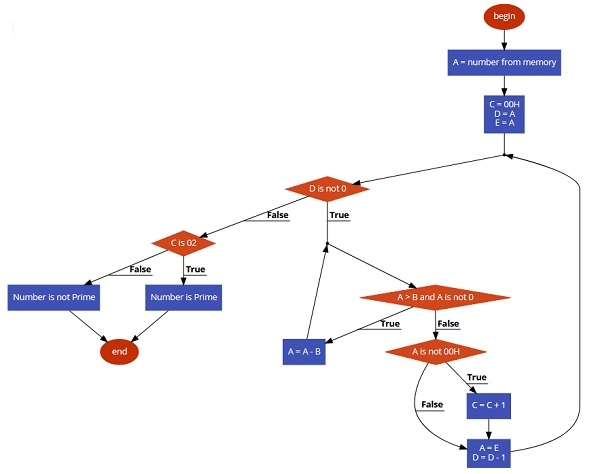
 Data Structure
Data Structure Networking
Networking RDBMS
RDBMS Operating System
Operating System Java
Java MS Excel
MS Excel iOS
iOS HTML
HTML CSS
CSS Android
Android Python
Python C Programming
C Programming C++
C++ C#
C# MongoDB
MongoDB MySQL
MySQL Javascript
Javascript PHP
PHP
- Selected Reading
- UPSC IAS Exams Notes
- Developer's Best Practices
- Questions and Answers
- Effective Resume Writing
- HR Interview Questions
- Computer Glossary
- Who is Who
8085 program to determine if the number is prime or not
In this program we will see how to check a number is prime or not using 8085.
Problem Statement
Write 8085 Assembly language program to check whether a given number is prime or not.
Discussion
Here the approach is little bit different. We are actually counting the number of unique factors. For prime numbers the factors are only two. The 1 and the number itself. So if the result is 02H, then it is prime, otherwise not a prime number. As there is no division operation, we have to perform division by subtracting repeatedly.
Input
|
Address |
Data |
|---|---|
|
F100 |
07 |
|
Address |
Data |
|---|---|
|
F100 |
FF |
|
Address |
Data |
|---|---|
|
F100 |
2F |
Flow Diagram

Program
| Address |
HEX Codes |
Labels |
Mnemonics |
Comments |
|---|---|---|---|---|
|
F000 |
21, 00, F1 |
|
LXI H,F100 |
Point to F100 to take the number |
|
F003 |
FE |
|
MOV A,M |
Take the number into Accumulator |
|
F004 |
0E |
|
MVI C,00 |
Clear C register |
|
F006 |
57 |
|
MOV D,A |
Copy A to D |
|
F007 |
5F |
|
MOV E,A |
Copy A to E |
|
F008 |
42 |
L2 |
MOV B,D |
Load B with D |
|
F009 |
B8 |
L1 |
CMP B |
Compare B with A |
|
F00A |
DA, 11, F0 |
|
JC LABEL |
if carry is generated, jump to Label |
|
F00D |
90 |
|
SUB B |
Subtract B from A |
|
F00E |
C2, 09, F0 |
|
JNZ L1 |
Jump to L1 |
|
F011 |
FE, 00 |
LABEL |
CPI 00 |
Compare A with 00H |
|
F013 |
C2, 17, F0 |
|
JNZ SKIP |
If Z = 0, jump to SKIP |
|
F016 |
0C |
|
INR C |
Increase C by 1 |
|
F017 |
7B |
SKIP |
MOV A,E |
Load A with E again |
|
F018 |
15 |
|
DCR D |
Decrease D by 1 |
|
F019 |
C2, 08, F0 |
|
JNZ L2 |
Jump to L2 label if Z = 0 |
|
F01C |
79 |
|
MOV A,C |
Load C to A |
|
F01D |
32, 01, F1 |
|
STA F101 |
Store result into F101 |
|
F020 |
76 |
|
HLT |
Terminate the program |
Output
|
Address |
Data |
|---|---|
|
F150 |
02 |
This is Prime
|
Address |
Data |
|---|---|
|
F150 |
08 |
This is not prime
|
Address |
Data |
|---|---|
|
F150 |
02 |
This is Prime

Advertisements
